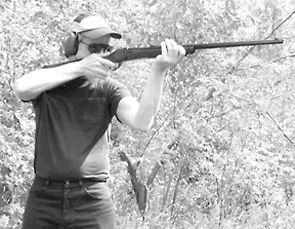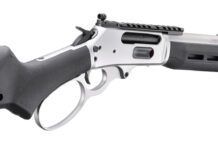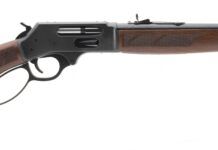
Back in February of this year we tested a group of Sharps rifles by Shiloh, Cabela’s and Cimarron. We found that although the other two versions were nice, we felt the price and several-years’ wait necessary for the Shiloh Sharps were well justified, because it was the nicest Sharps rifle of the bunch. But can you get a good .45-70 single shot that’s not a Sharps, and would you want to? Let’s find out.
We obtained a nearly new Ruger No. 1S and a brand-new Browning 1885, both in .45-70, to test against our previous best single-shot, the Shiloh Sharps. These two rifles, while contemporary, both resemble — at least slightly — older rifles from the time of the Sharps. They were not precise copies of earlier rifles, though the Browning came close. We wanted to see how well they’d hold up to the Shiloh Sharps’s quality, and to see if they were better buys for you, the lover of single shot .45-70s.
The two newer guns had a tough opponent in the Shiloh, as we noted in the February 2001 issue. The feel of the Shiloh’s action was like that of a fine watch. It opened with precision, and shut like the old bank-vault door. There were no machining marks visible anywhere. The inletting was perfection. The sights could be whatever you wanted them to be and agreed to pay for, except (as far as we could tell) there were no provisions for modern scope mounting. Accuracy with the costly aperture sights that were fitted on our test sample was all we could hold for in the dismal light conditions in which we tested this rifle. The better we could see and hold and squeeze, the tighter were our groups.
This was the standard against which we gauged the Browning and the Ruger’s performances. How did they do? Read on to find out:
Browning Model 1885 High-Wall, $997
Browning attempted to capture the look of the high-wall Winchester of a century ago. However, the Japanese folks who made this Browning decided to put a glassy finish on this historic-minded rifle, which didn’t do it any good. Old Winchesters never had glassy-finish stocks, nor did they have buffed barrels that lost the sharp edges of the octagon. So right off the bat, this rifle didn’t look right because of its glitzy finish. However, the profile and mechanism of our test rifle looked a lot like a High-Wall Winchester, and the rifle had some well-done features.
[PDFCAP(1)]
Until recently, Browning offered a higher-priced “Traditional Hunter” version of this rifle, which had an oil-type finish. These have been recently discontinued, but you may still be able to find one. Another Browning option was the BPCR, which stands for Black Powder Cartridge Rifle. These sold for nearly $1,800, and are also recently discontinued. They were offered in .40-65 and .45-70, and didn’t sell very well.
This was no lightweight. Empty, the rifle weighed 8 pounds, which was a little closer to the 10.5-pound weight of the Sharps than the 7-pound Ruger was. Part of the extra weight of the Browning was in its 28-inch barrel, compared to the Ruger’s 22-incher.
Opening the 1885’s action caused the hammer to be cocked as the action block moved downward. With the action closed, if the hammer were lowered slowly, it did not strike the firing pin, nor could it be moved by any means to make contact with the pin. However, a normal pull on the trigger would cause the cocked hammer to strike the firing pin and fire the rifle. This feature would be handy whenever you wanted to carry a loaded but uncocked rifle. In spite of that, the serrations on the hammer were not deep enough for us.
The wood was extremely attractive, and both sides of the stock had the same grain pattern. The glassy stock finish tended to hide the wood’s great beauty under glaring hot spots. Some sort of dull oil-looking finish would have been far better than the very glossy finish applied. We suspect it was an epoxy finish because it was nearly unmarkable, extremely hard, filled the pores perfectly, and had a mirror-like surface. The forend wood matched the beautiful grain structure of the buttstock very well. Both pieces of wood had excellent checkering in five well-proportioned panels, three of them on the forend. There were QD sling swivel studs. The butt was padded with thick black rubber that was just as hard as that of the Ruger, if not harder. We wish the makers of these two rifles would shoot them with some of the Buffalo Bore heavy loads, to see what they’re doing to their sales by putting these “cast-iron” buttplates on their otherwise very nice rifles. Anybody buying a .45-70 rifle in 2001 is going to shoot it with heavy loads, at least part of the time. Both rifles were perfectly capable of handling loads that would drop an elephant. Manufacturers need to get wise to this, and put reasonable pads on their rifles. Surely any changes to pull length to fit individuals should be achieved with the use of a good recoil-absorbing pad.
The metal polish was, as already stated, somewhat overdone. The action flats were good and flat, with no polishing marks anywhere. The edges were just the right amount of sharp. Unfortunately, the octagonal barrel was a bit too well polished. All the flats of the barrel except the very top one were slightly rounded, and the sharp edges between flats were not sharp enough. The maker’s name and other information was stamped into the barrel flats, leaving slightly raised and unsightly lettering. The bluing was flawless. It was a rich, deep blue-black on all metal parts except the trigger, which was gold-plated, and the falling block itself, which was left white. The block’s polish was excellent, with no machining marks visible, unlike the Ruger’s.
The trigger guard, which was also the action lever, had the Browning logo in gold inlaid into its bottom. The inletting was very good, though the forend appeared to be putting more pressure on the left side of the barrel than on the right. Metal fitting was outstanding throughout.
The action and barrel were tapped with holes for a scope base, and the holes filled with tiny screws. The rear sight was a buckhorn, adjustable for elevation by a sliding wedge, and for windage by drifting. The front sight was a square-sided blade which appeared to the eye as a thin flat-top post, adjustable for windage by drifting. One delightful effect of the half-moon cutout of the buckhorn sight was that the front blade, which appeared to older eyes as a blur when seen by itself, sharpened up perfectly when seen through the rear sight. The trigger pull was crisp and clean at 4 pounds, and we looked forward to shooting this rifle.
[PDFCAP(2)]
At the range, we found the Browning very gentlemanly in its manners. It had a distinctly different feel with its long barrel. The action worked very smoothly and well, and we had no problems with it at all. There was a small blade that could be turned either in the way, or out of the way of ejected shells, to make retrieving empties easier. We left it in the way, and our ejected empties were easily found. Recoil with the hardest-kicking load, which seemed to be the 350-grain BB fodder, was nasty. The rifle also kicked up into the cheekbone, which hurt as much as, or more than, the bang on the shoulder. But as stated above, there’s no need to shoot more than a few of these rounds from the bench. Fun is to be had with light handloads. Our best 100-yard group with the test ammunition was 2.0 inches, fired with the 430-grain BB cast lead load, which went across the chronograph at 1,985 fps. That’s not too far behind a .458 Win. Mag.
Ruger No. 1S, $774
The Ruger No. 1 is an approximation of the falling-block Farquharson of the latter days of the 19th century, and the big rimmed .45-70 case seemed very much at home in this version of the rifle. Our test rifle had a 22-inch barrel and iron sights. Its grooved forend was a direct copy of the Alexander Henry forend of the late 1800s, and the stock design was pure classic, but the rifle was thoroughly modern in design and manufacture. Like so many of Ruger’s products, this rifle’s action began life as an investment casting. The Ruger Co. is a master of that technique, perhaps the very best in the world. The Ruger people have the ability to formulate metal mixes, heat treatment and even mould configuration to get steel parts that in many cases are stronger than items made by almost any other technique.
[PDFCAP(3)]
We have read that Bill Ruger used to have on his desk a sample of his No. 1 rifle that had been fired with proof loads, with a cleaning rod intentionally jammed in the barrel. Nothing let go.
Our test Ruger was stocked with a nice piece of black walnut, with a reasonably well-matched forend. The grain of the buttstock didn’t match, side to side, but both sides were attractive. The buttstock had a well-fitted black rubber butt pad, but it was both thin and hard, and we expected this rifle to kick significantly with hot loads. The checkering was well done and of appropriate size on pistol grip and forend. The wood was slightly larger than the metal all over, except at the right side of the top tang, where the metal was higher than the wood. Inletting was excellent. The stock’s finish was very hard and matte-surfaced, but wasn’t entirely smooth, nor were the pores perfectly filled.
Metal polish and bluing were excellent. The sides of the action were flat, and the barrel showed no waviness. There was a folding rear sight with white central diamond affixed to the quarter rib, and the rib was screwed securely to the barrel. The rib had Ruger scope-base grooves and notches milled into it. The front sight was a high, unprotected bead on top of a rib that was fastened to the barrel by a band. The front blade was easily replaceable by depressing a spring-loaded button and sliding the blade forward off the front rib. There was also a barrel-band front sling eye, and another one under the buttstock, for QD sling swivels.
The sliding tang-mounted safety was non-automatic. It was difficult to put it on, requiring more force than we liked. The safety could only be put on with the rifle cocked, and it was possible to cycle the action with the safety on. The rifle had an ejector mechanism, and it threw empties out with enough vigor. The trigger pull was 4.5 pounds, with a perfectly clean break.
With its 22-inch barrel, the 7-pound rifle was only 38.5 inches long, which is a mighty compact unit. We feel a scope would ruin the look and feel of this rifle, but if one were necessary it ought to be one of the smallest optics made, or else the handiness of this little single shot would be entirely lost.
We tested the Ruger and the Browning rifles with Buffalo Bore’s ([208] 756-8085) new .45-70 Magnum fodder, which features small-rifle primers. BB went to those because in some lever rifles it’s possible for a round to be loaded into the magazine so that the edge of a flat-point bullet rests against the primer of the round ahead of it in the tubular magazine. BB’s research indicated at least one round had gone off within someone’s tubular magazine, when the nose of the canted bullet was driven into the primer of the round ahead of it by recoil. The smaller primer hole makes it far harder, if not impossible, for that to happen. We used Buffalo Bore’s 350-grain JFN and 430-grain LFN loads. BB also offers a 405-grain JFN load. We also tried Winchester’s 300-grain semi-jacketed hollow points.
At the range, as predicted, we got kicked severely with the hot BB .45-70 Magnum loads. They are for those who enjoy getting kicked, or for the most serious hunting use against the larger forms of game animals. They’re not for fun. The Winchester 300-grain JHP loads were much more pleasant, and in the Ruger they shot into adequately small groups. Our best effort was a 2.5-inch 100-yard group with the Winchester load.
The gun’s iron sights sucked, to put it mildly, in bright side-light. We found the front sight of the Ruger was impossible to define in bright sunlight, because the rounded front bead threw glare that made getting a good sight picture impossible. The setup on the Browning was far superior. A simple front blade with squared back and top would be ideal, and if we could get such a sight from Ruger, or arrange to have one custom made, that’s what we’d slip into the dovetailed slot on the front rib of this rifle. A hood would have helped with any front sight in glaring sun, but there was no provision for one.
Gun Tests Recommends
Browning Model 1885 High-Wall, $997. Buy It. Though we didn’t care for the shiny finish, the Browning was a well-made rifle that shot very well. We’re sure better eyes could beat our test results. With its long barrel and short forend it had a look and feel more like an ancient rifle than the Ruger did. There were no problems with the Browning at all, other than that we didn’t want to stop shooting it with lighter loads.
Ruger No. 1S, $774. Buy It. The Ruger worked very well, was a very attractive rifle, and offered acceptable accuracy. It was very lively and fast handling, being a compact package, and yet had enough steadiness for reasonable offhand work. We found the somewhat straighter butt of the Ruger resulted in less kick to the face than from the Browning as the rifle rose in recoil, so the stock design helped reduce the difference in felt recoil between the 7-pound Ruger and the 8-pound Browning. This rifle seriously needed a softer butt pad. Other than that, we liked it, and believe you will too.
Shiloh 1874 Hartford Model Sharps, $1,702. Best of Class. We’ve tested several single-shot .45-70s recently, and we still think this gun is the best of the lot. It was an exact reproduction of the Sharps, with little effort or expense spared to make it look just right. The Shiloh had it all: looks, wood, fit, finish, accuracy, extras, you name it. If you want a new “Sharps,” the Shiloh is the nicest we’ve seen, and well worth its base price of around $1,700. For that money you get a 10.4-pound rifle with 30-inch octagonal barrel, the flats of which were dead flat, and the edges quite sharp. Also, the action was perfectly flat where it should have been, with sharp edges. The case coloring of the action was perfectly done and very attractive, and the bluing on the barrel gave the rifle a rich look.
Neither the Ruger nor the Browning came close to the Shiloh’s historic appeal or sense of romance. If you want a good “old” rifle, buy the Shiloh, (406) 932-4454. However, the Ruger and Browning are two viable .45-70 options, and would be fun to shoot while you wait for your Shiloh. They’re good enough that you may find you no longer need a Sharps … but we doubt it. The best guns will always hold their own.



























